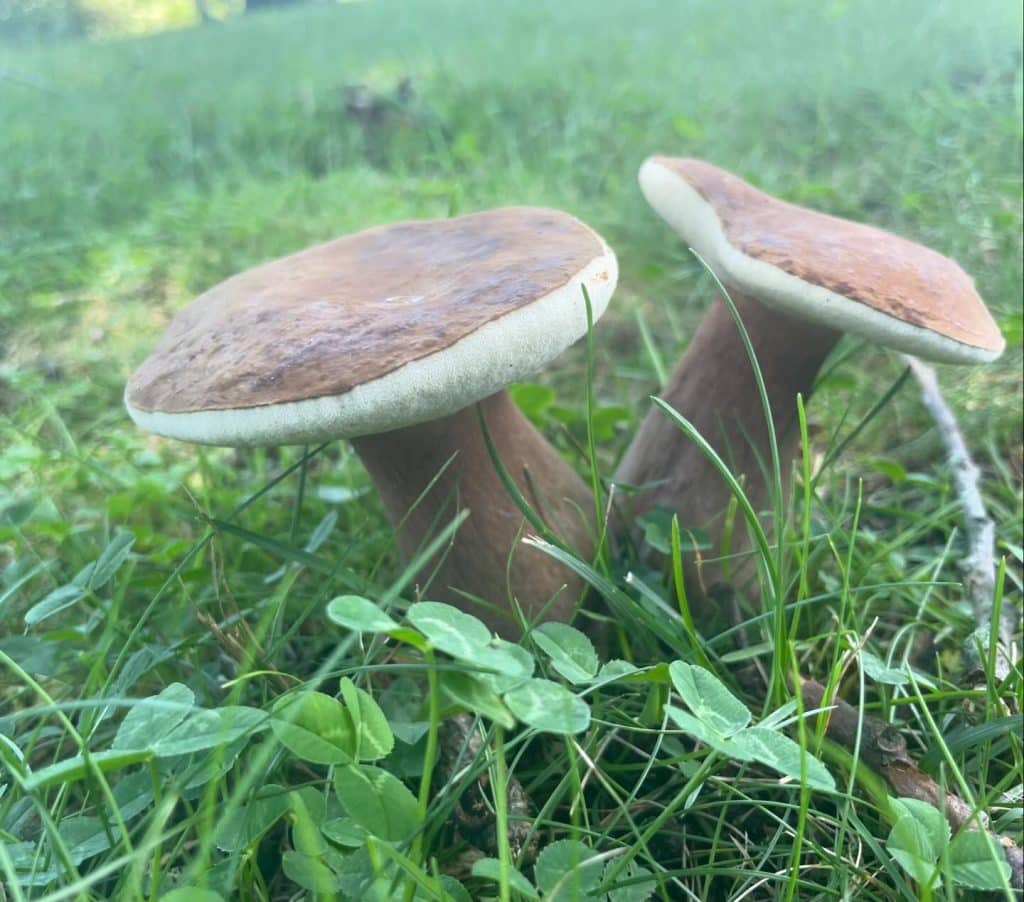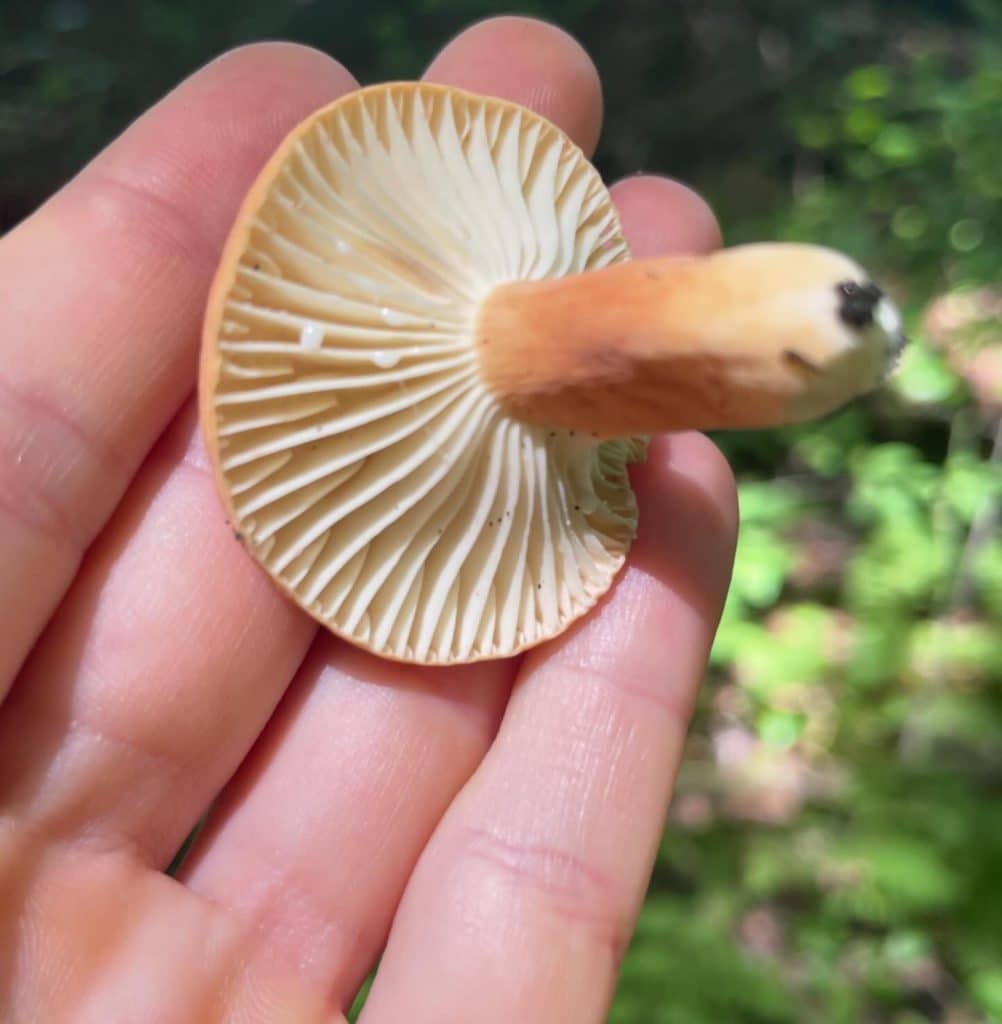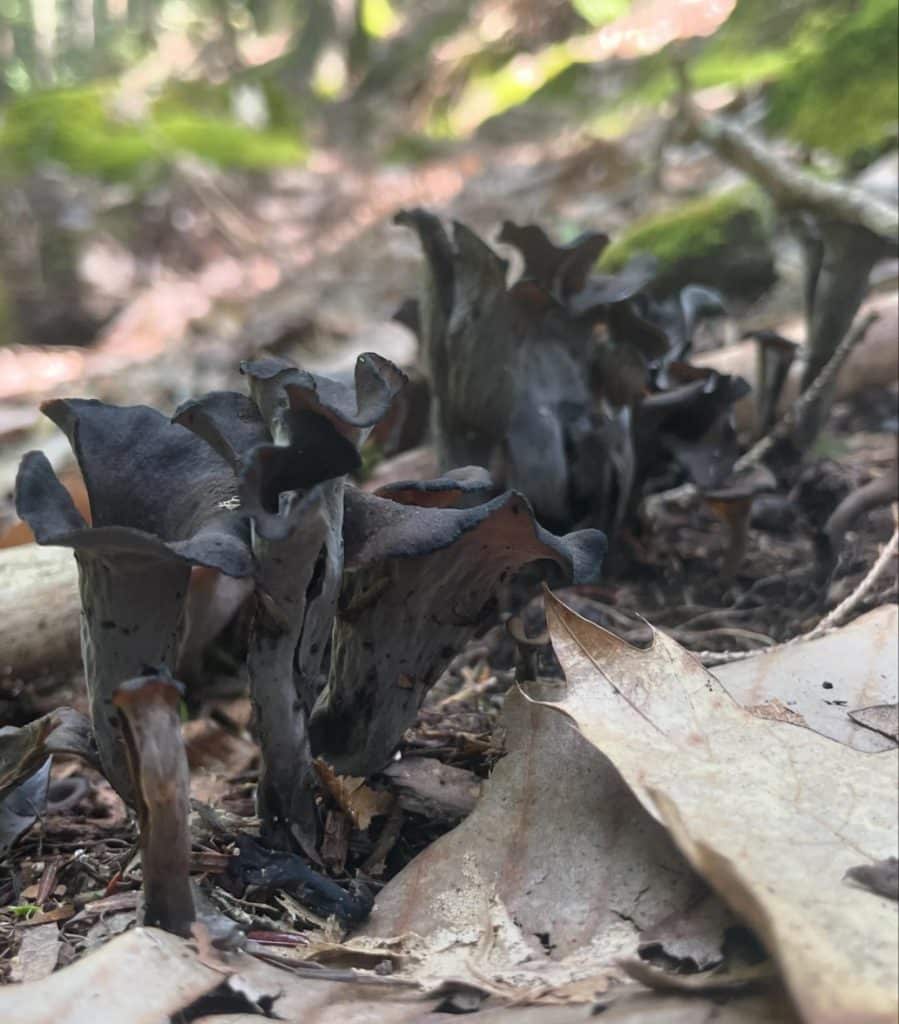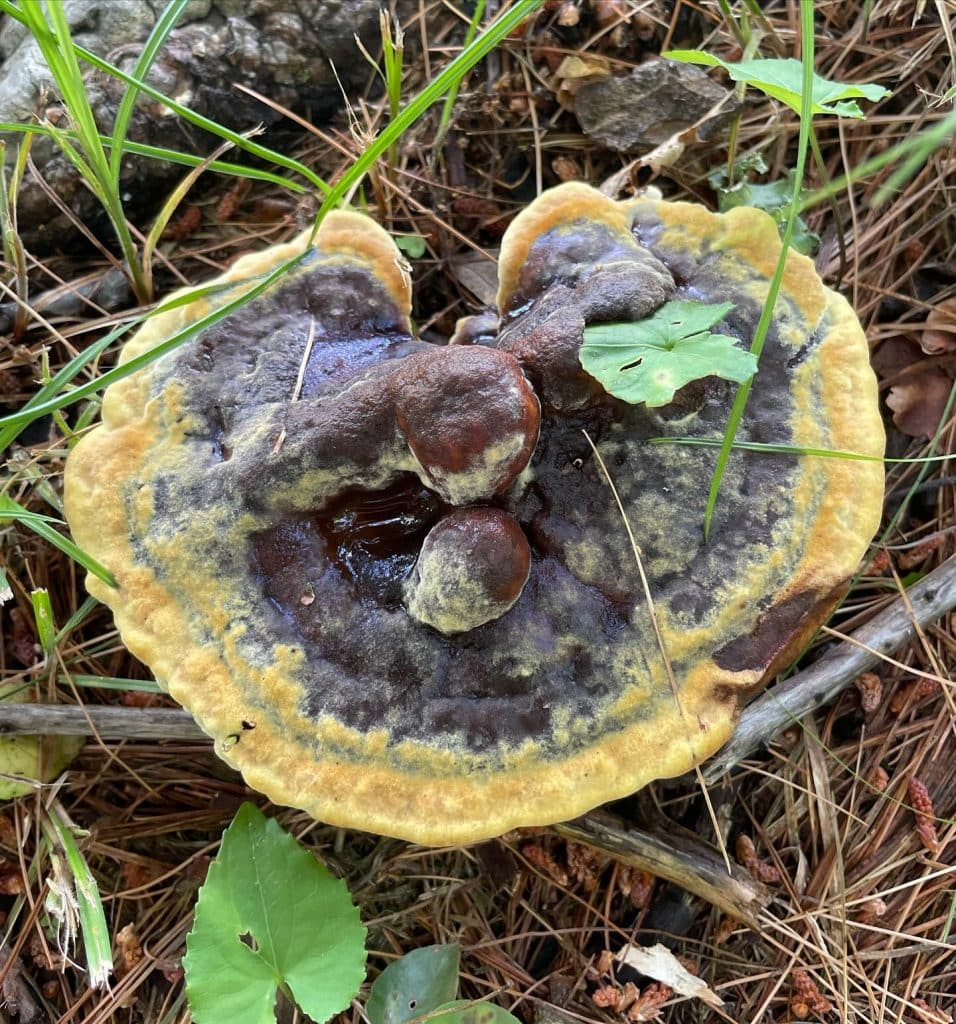Strobilomyces sp. – Old Man of the Woods

The Old Man of the Woods (Strobilomyces sp.) is an edible mushroom that fruits June-October. It can be found growing singularly or clustered in mixed hardwood or conifer forests. The cap and stem are gray to black and shaggy. Pores start off white, then turn gray and eventually black with age. Flesh turns reddish when […]
Suillus spraguei – Painted Suillus

The Painted Suillus (Suillus spraguei) is an edible mushroom that can be found in conifer forests from June-October. The mushroom grows scattered or clustered in the ground. It is a mycorrhizal mushroom that often associates with pine. The Painted Suillus has a unique scaly red cap and stem. The yellow pores are covered by a […]
Tylopilus ferrugineus

Tylopilus ferrugineus is an edible mushroom that is native to eastern North America. It fruits July-September. The mushroom is often found in grassy areas in association with oak or beech. The cap and stem are brown. The pores are white and stain brown. Young mushrooms have club-shaped stems and very firm flesh. Spore print is […]
Xerocomus illudens

Xerocomus illudens is an edible bolete that fruits July-October. It forms mycorrhizal relationships with oaks and possibly other hardwoods. The cap is cinnamon-brown or pinkish-cinnamon colored. The pores are lemon yellow and angular. The flesh is pale yellow and does not stain blue. The stem is mustard-yellow and has a course net. Spore print is […]
Macrolepiota procera – Parasol Mushroom

The Parasol mushroom (Macrolepiota procera) is an edible mushroom that fruits August-October. It can be found in open woodlands near conifers or hardwoods or on lawns. The parasol mushroom is saprobic. The cap has scattered brown scales and develops a rounded bump on the center. The stem is slender, tall, and bulbous at the base. […]
Sarcodon imbricatus – Scaly Hedgehog

The Scaly Hedgehog (Sarcodon imbricatus) is an edible, but often bitter mushroom that can be found July-November. It grows in the ground near water or in hilly areas. The mushroom is often found growing near conifers, especially spruce. The scaly hedgehog, also known as “Hawk’s wing”, has raised brownish scales on its cap. Under the […]
Baorangia bicolor – Bicolor Bolete

Bicolor Bolete (Baorangia bicolor) is an edible mushroom that can be found from June-October. It has a mycorrhizal relationship with oak and other hardwood trees. Bicolor boletes grow in the ground scattered or in small clusters. The cap is pinkish to dark red. Occasionally young mushrooms will have a yellow cap. The pore surface is […]
Lactifluus hygrophoroides – Hygrophorus Milk Cap

Hygrophorus milk cap (Lactifluus hygrophoroides) is an edible mushroom that can be found in the eastern United States. It fruits late summer to early fall. The Hygrophorus milk cap forms mycorrhizal relationships with oaks and potentially other hardwoods. It grows singularly on the ground near its host tree. The cap is pale orange to reddish-brown […]
Phylloporus rhodoxanthus – Gilled Bolete

The Gilled Bolete (Phylloporus rhodoxanthus) is an edible mushroom that can be found June-October. It is mycorrhizal with beech and oak. Phylloporus rhodoxanthus is the most common gilled bolete mushroom in North America. There are 6+ species of gilled boletes in North America. The gilled boletes have a bolete-like shape with a thick cap and […]
Craterellus ignicolor – Flame Chanterelle

Flame Chanterelle (Craterellus ignicolor) is a choice edible mushroom that is native to eastern North America. It can be found July-November in swampy forests. The flame chanterelle, also known as “yellowfoot chanterelle” can tolerate very wet environments. It is often found growing in clusters in moss of hardwood forests. It is mycorrhizal with oaks, beech, […]
Craterellus fallax – Black Trumpet

Black trumpets (Craterellus fallax) are a delicious wild mushroom whose flavor is compared to truffles. Black trumpets can be found summer to fall. They often fruit in moss, near oak and beech trees. Black trumpets can be either mycorrhizal or saprobic. They are in the same family as chanterelles and are often found growing in […]
Coprinopsis variegata – Scaly Ink Cap

The Scaly Ink cap (Coprinopsis variegata) is a decomposer with questionable edibility. The scaly ink cap can be found growing on decaying hardwoods in eastern North America. It fruits summer-fall. The cap is covered by a felty, whitish veil when young. The veil soon breaks into large, felty patches revealing a brownish yellow surface underneath. […]
Cantharelles appalachiensis – Appalachian Chanterelle

The Appalachian chanterelle (Cantharelles appalachiensis) is a species of chanterelle that is native to eastern North America. It can be differentiated from other chanterelle species by its pale to yellowish-brown coloration. The Appalachian chanterelle is a summer mushroom that can be found in hardwood forests. Chanterelle mushrooms can be identified by their decurrent gill-like ridges […]
Phaeolus schweinitzii – Dyer’s Polypore

Dyer’s Polypore (Phaeolus schweinitzii) is a pathogenic polypore that causes butt rot on conifers. The mushroom can be found summer-fall on the roots of conifer trees. The mushroom is composed of multiple circular caps. The caps are densely hairy, giving the mushroom a velvety appearance. The caps start yellowish and become brownish with age. The […]
Pluteus cervinus – Deer Mushrooms

Deer mushrooms (Pluteus cervinus) are common edible mushrooms that can be found around the world. There are 40+ species of Pluteus in North America. All species in this genus are wood rotters with free gills and pinkish spore prints. Some Pluteus mushrooms are edible, some are psychoactive, and some are too small to forage. Deer […]
Auricularia nigricans – Ear fungus

Ear fungus (Auricularia nigricans) is a wood-rotting mushroom that can be found growing singly or in clusters on dead or dying trees. The ear fungus (A. nigricans) can be differentiated from other wood ear fungi (mushrooms in the Auricularia genus) by its upper surface which is ash-gray to yellowish brown and hairy. Wood ear mushrooms […]
Cantharellus minor – Small Chanterelle

The Small chanterelle (Cantharellus minor) is an edible, although unsubstantial mushroom. Small chanterelles are mycorrhizal with hardwood trees. They are often found in moss, under oak trees. Chanterelles can be identified by their decurrent false gills. Small chanterelles look very similar to golden chanterelles but have a slenderer and hollow stem. Although the small chanterelle […]
Agaricus campestris – Meadow Mushrooms

Meadow mushrooms (Agaricus campestris) are the edible wild cousin of the white button mushroom (Agaricus bisporus). Meadow mushrooms can be identified by their pink gills that turn dark brown with age and their dark brown spore print. The mushroom should not turn yellow when handled and should not be growing from a vulva. Meadow mushrooms […]
Artomyces pyxidatus – Crown-tipped Coral

Crown-tipped coral (Artomyces pyxidatus) is an edible mushroom that can be found from June-September. It fruits on dead or dying wood, which is unique in the coral fungi group. Crown-tipped coral is always a shade of white and has crown-like branch tips. It has a mild peppery flavor and cooks very quickly. It is best […]
Laetiporus cincinnatus – White-pored Chicken of the Woods

White-pored Chicken of the Woods (Laetiporus cincinnatus) is an edible polypore found growing at the base of oak trees from July-October. There are multiple Laetiporus (Chicken of the Woods) species. The white-pored chicken of the woods is known to be the best tasting species. Laetiporus cincinnatus is lighter colored than other Laetiporus species. It grows […]
